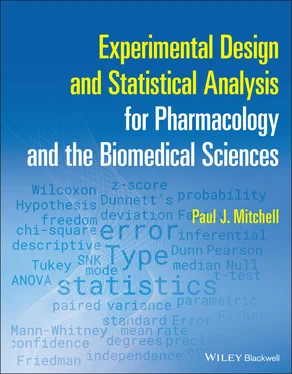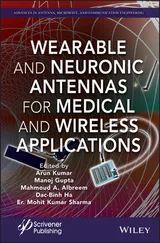Paul J. Mitchell - Experimental Design and Statistical Analysis for Pharmacology and the Biomedical Sciences
Здесь есть возможность читать онлайн «Paul J. Mitchell - Experimental Design and Statistical Analysis for Pharmacology and the Biomedical Sciences» — ознакомительный отрывок электронной книги совершенно бесплатно, а после прочтения отрывка купить полную версию. В некоторых случаях можно слушать аудио, скачать через торрент в формате fb2 и присутствует краткое содержание. Жанр: unrecognised, на английском языке. Описание произведения, (предисловие) а так же отзывы посетителей доступны на портале библиотеки ЛибКат.
- Название:Experimental Design and Statistical Analysis for Pharmacology and the Biomedical Sciences
- Автор:
- Жанр:
- Год:неизвестен
- ISBN:нет данных
- Рейтинг книги:5 / 5. Голосов: 1
-
Избранное:Добавить в избранное
- Отзывы:
-
Ваша оценка:
- 100
- 1
- 2
- 3
- 4
- 5
Experimental Design and Statistical Analysis for Pharmacology and the Biomedical Sciences: краткое содержание, описание и аннотация
Предлагаем к чтению аннотацию, описание, краткое содержание или предисловие (зависит от того, что написал сам автор книги «Experimental Design and Statistical Analysis for Pharmacology and the Biomedical Sciences»). Если вы не нашли необходимую информацию о книге — напишите в комментариях, мы постараемся отыскать её.
Experimental Design and Statistical Analysis for Pharmacology and the Biomedical Sciences
in vitro
in vivo
priori
Experimental Design and Statistical Analysis for Pharmacology and the Biomedical Sciences
Experimental Design and Statistical Analysis for Pharmacology and the Biomedical Sciences — читать онлайн ознакомительный отрывок
Ниже представлен текст книги, разбитый по страницам. Система сохранения места последней прочитанной страницы, позволяет с удобством читать онлайн бесплатно книгу «Experimental Design and Statistical Analysis for Pharmacology and the Biomedical Sciences», без необходимости каждый раз заново искать на чём Вы остановились. Поставьте закладку, и сможете в любой момент перейти на страницу, на которой закончили чтение.
Интервал:
Закладка:
For the last 15–20 years or so, I have worked very closely with Prof John Kelly, Department of Pharmacology and Therapeutics, NUIGalway, during which we have tried, successfully it must be said, to develop a fully integrated series of lectures and workshops to teach undergraduate and postgraduate students in pharmacology, neuropharmacology, toxicology, and drug discovery the vagaries of robust experimental design and statistical analysis. I still travel to Galway every year to expose John's postgraduate students to an English sense of humour in my attempt to run hands‐on statistical workshops – I must be doing OK as John keeps inviting me back! My sincere thanks to John for all the support and encouragement he has given me during that time and to other colleagues in Galway, notably Ambrose O’Halloran and Sandra O'Brien, who were instrumental in preparing the initial versions of the lectures, which I now subject my own students to back in Bath and which are closely aligned to the contents and flavour of this book.
During the life of this project, I have worked closely at various times with the management team for the British Pharmacological Society and I would like to convey my thanks to David James (Executive Director, Business Development) for his initial help and advice to get this project off the ground, and latterly to Katherine Wilson (Director, Research Dissemination) and Lee Page (Head of Education and Engagement) for their help and advice on ‘what to do next’!
I am also very grateful to everybody at Wiley from Alison Oliver, who as Publications Manager and Commissioning Editor back in 2016 took a risk and encouraged me to put my ideas into a proposal, which subsequently became a formal agreement between myself and Wiley, to James Watson (Publications Manager), Kimberly Monroe‐Hill (Managing Editor), and Tom Marriott (Assistant Editor, Health and Life Sciences) who have guided me through all the steps following formal submission of the final manuscript through to publication. My thanks also to the reviewers of my initial proposal to Wiley who thought this project was a good idea, who have encouraged me to complete the project ever since (hi John and Steve, you know who you are) and who also opened my eyes that this work may be not only useful within the realm of pharmacology but also throughout the biomedical and life sciences!
My career in pharmacology has taken me from the pharmaceutical industry with Beecham Pharmaceuticals in the 1970s and 1980s, through my PhD studies at the University of Bath in the latter half of the 1980s (under the invaluable supervision of Prof Peter Redfern), then back to the industry with Wyeth‐Ayerst in 1989 before returning to the University of Bath in 1995 where I have remained ever since. Throughout that time in industry and academia, I have worked with a wide range of wonderful, highly skilled, individuals and made life‐long friends too numerous to name individually here (but you should all know who you are on both sides of the Atlantic Ocean). I shall remain eternally grateful for all your help, guidance, encouragement, patience, comments, critique (usually constructive), and tutelage throughout my career in pharmacology.
Statistical Packages
You will note that at the end of most of the chapters in this book, I have been able to provide screenshots from the software packages that I used to analyse the examples used in the book. This was for two purposes. First, this allowed me to check my own calculations for every single example and statistics test described herein (yes; every example has been analysed in the good old‐fashioned way by hand and a good calculator – good God, what a geek I hear you cry – and you'd be right as my academic colleagues keep telling me!), and second, I hope that when you run your own data analysis you will now be forewarned about what to expect (and not be surprised) by the output from the software you have used. To that end, I am most grateful to the software companies concerned for permission to reproduce screenshots from their software. Consequently, screenshots from GraphPad – Prism®Statistics software version 8.2 and above are printed with permission of GraphPad Software, San Diego, California, USA; screenshots from MiniTab software version 18 and above are printed with permission of MiniTab, LLC; screenshots from InVivoStat are reprinted with permission of the InVivoStat team (specifically Simon Bate); and finally screenshots from IBM® SPSS® Statistics software (SPSS) version 26 and above are printed with permission from International Business Machines Corporation (IBM).
Homo Sapiens – Part 2
I've been very lucky to have a number of very close friends who have remained loyal regardless of where my career has taken me, so a special mention to Dave Bragg (‘Braggy’), John Clapham (JC), and Alan Rainbird for your unwavering friendship (which I value more than words can ever express) since we first met over 45 years ago, John Kelly ( see above ), and more recently to Kevin McDermott for dragging me out most Saturday mornings to the golf course to clear our heads for a few therapeutic hours away from the stress of our professional lives, see you on the first tee mate!
Finally (!), all my love to my wife Angela and my children Matthew and Samantha – how you all ever put up with such a cantankerous old git as myself (especially during the last four years or so while I worked on this manuscript) I shall never know. You are all my rock, and I will always be forever grateful.
Foreword
For the last 25 years or so, I have become increasingly involved in teaching the fundamentals of statistical analysis of experimental data to, initially, pharmacy and pharmacology undergraduates but, more lately, undergraduates in other disciplines (e.g. natural sciences, biomedical sciences, biology, biochemistry, psychology, and toxicology) and postgraduate students and early researchers in these and more specific areas of pharmacological research (e.g. neuropharmacology). Throughout this time, I have become increasingly aware of the statistical rigour required by scientific journals for publication of scientific papers to be approved. However, this has been coupled with increased anxiety on the part of both new and experienced researchers as to whether their statistical approach is correct for the data generated by their studies. These observations suggest that in the past the teaching of experimental design and statistical analysis has been poor across the sector. Indeed, if I mention stats (sic) to most researchers, they hold their hands to their face and perform an imitation of Edvard Munch's Der Schrei der Natur (‘The Scream of Nature’, or more commonly known as just ‘The Scream’)! Statistical analysis is often viewed as burdensome and an inconvenient chore, generally borne out of ignorance and a lack of appreciation of how useful rigorous statistical analysis may be.

Der Schrei der Natur (circa 1893), Edvard Munch (1863–1944)
I'll give you three examples:
Example 1:
On various occasions, I have had final year undergraduate students bang on my office door; I say bang – it was definitely more than just a polite knock, probably borne out of fear (of me? Never!), frustration, or sheer panic, holding a raft of printed data in one hand and a mug of coffee in the other ( so how did they bang on the door? ). After a period of trying to quell their anxiety, it seems that the student had been sent to me to gain advice on how to analyse the plethora of data generated by their final year project. My initial response has always been ‘I'm sorry, I can't help you!’. At this point, the student invariably looks at me incredulously and dissolves in floods of tears, sobbing ‘but you must help me, my project report is due in tomorrow ( why is it always tomorrow? ), and my supervisor said you are the stats guru and would be happy to help – I have nobody else to turn to and I really want a first' ( don't they always )! I then explain to them that good scientific research is achieved by good experimental technique. This involves high‐quality experimental design not only of the experimental protocol involved but also the identification of how the resulting data are to be analysed. I then tell them to return to their supervisor and explain that the data are worthless and should be binned forthwith, that they need to sit down and go over their experimental design and build into their protocols the exact method by which they will analyse the resulting data before they perform any of the planned experiments. Good experimental design requires knowledge about the expected experimental output; what type of data will my experiment generate? It is only with this knowledge that the appropriate statistical techniques may be identified. The statistical tests used are an important component of the Methodology , and as such must be identified before getting your hands dirty and performing the experiments. Once the student and supervisor have identified the appropriate statistical approach, then the student can perform the experiments and gather the resulting data. The student's response (in between further floods of tears and sobs) is something along the lines of ‘so all this data is worthless ( yes )? I need to identify the stats tests to use ( yes !)? And then I do the experiments ( yes!! )? BUT MY REPORT IS DUE IN TOMORROW ( Tough! Not my problem )!!’ Whereupon the student invariably storms out of my office, reams of paper in one hand, coffee mug in t'other, slamming the door behind them ( how do they do that if their hands are full? ). 300 ms later either my phone rings or there are further knocks on my office door – it's the supervisor concerned, and rather irate! (I exaggerate here – I've never known an academic move that fast.) After carefully explaining the requirements of good experimental design and statistical analysis (to somebody who, let's face it, should know this anyway!), I finally agree to look at the student's data and provide advice as to how the data may be analysed. Interestingly, in subsequent years, it is the same supervisor's students who bang on my door seeking advice (again, too late in my opinion), so perhaps you can't teach an old dog new tricks. Most importantly, however, it is a lesson learnt by the student, so at least the next generation of pharmacologists have a fair chance of getting it right!
Читать дальшеИнтервал:
Закладка:
Похожие книги на «Experimental Design and Statistical Analysis for Pharmacology and the Biomedical Sciences»
Представляем Вашему вниманию похожие книги на «Experimental Design and Statistical Analysis for Pharmacology and the Biomedical Sciences» списком для выбора. Мы отобрали схожую по названию и смыслу литературу в надежде предоставить читателям больше вариантов отыскать новые, интересные, ещё непрочитанные произведения.
Обсуждение, отзывы о книге «Experimental Design and Statistical Analysis for Pharmacology and the Biomedical Sciences» и просто собственные мнения читателей. Оставьте ваши комментарии, напишите, что Вы думаете о произведении, его смысле или главных героях. Укажите что конкретно понравилось, а что нет, и почему Вы так считаете.












